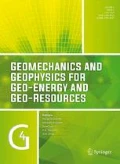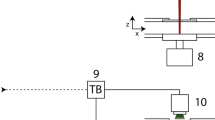Abstract
High-power laser has been considered as a potential method of rock breakage through melting. However, high energy consumption and low efficiency are the main restrictions for applying laser technology in rock excavation and fragmentation. A new rock breakage method which combines pulsed laser and induced cavitation is described in this paper, with potentially low energy consumption and high efficiency in rock fracturing. Cavitation is the rapid formation and collapse of vapour bubbles within a liquid. The irradiation of a pulsed laser beam with the energy density beyond the breakdown threshold of a liquid could induce cavitation bubbles in the liquid. The energy of the laser beam converts into highly pressurised cavitation bubbles. When the cavitation bubbles explode near rock surface, the explosions induce dynamic force to break the rock. In this paper, a series of tests using continuous and pulsed laser beams to break rocks in both air and water are presented. It is found that the pulsed laser in water produced the best rock-breaking efficiency without melting the rocks. Further analysis of the crater morphology and mechanical properties suggests the dynamic force at cavitation bubble explosion is the main cause of rock fracturing. The study leads to the conclusion that the pulsed laser induced cavitation in water is potentially an effective way for laser rock cutting technology with industrial applications.

(reproduced from IET 2016)












Similar content being viewed by others
References
Andres U (1995) Electrical disintegration of rock. Min Process Extract Metall Rev 14(2):87–110. https://doi.org/10.1080/08827509508914118
Arndt RE (1981) Cavitation in fluid machinery and hydraulic structures. Annu Rev Fluid Mech 13(1):273–326. https://doi.org/10.1146/annurev.fl.13.010181.001421
Chen X (2004) Studies on mechanisms of the interaction between high-power laser and matter in water. Dissertation, Nanjing University of Science and Technology (in Chinese). https://doi.org/10.7666/d.y625530
Chen X, Xu RQ, Shen ZH et al (2004) Optical investigation of cavitation erosion by laser-induced bubble collapse. Opt Laser Technol 36(3):197–203. https://doi.org/10.1016/j.optlastec.2003.08.004
Cho SH, Cheong SS, Yokota M, Kaneko K (2016) The dynamic fracture process in rocks under high-voltage pulse fragmentation. Rock Mech Rock Eng 49(10):3841–3853. https://doi.org/10.1007/s00603-016-1031-z
Erfan M, Shahriar K, Sharifzadeh M et al (2017) Moving perforation of rocks using long pulse Nd: YAG laser. Opt Lasers Eng 94:12–16. https://doi.org/10.1016/j.optlaseng.2017.02.010
Gahan BC, Parker RA, Batarseh S, Figueroa H, Reed CB, Xu Z (2001) Laser drilling: determination of energy required to remove rock. In: SPE annual technical conference and exhibition. Society of Petroleum Engineers. https://doi.org/10.2118/71466-MS
Graves RM, O’Brien DG (1998) StarWars laser technology applied to drilling and completing gas wells. In: SPE annual technical conference and exhibition. Society of Petroleum Engineers. https://doi.org/10.2118/49259-MS
Hagan PC (1992) The cuttability of rock using a high pressure water jet. In: Western Australia conference on mining geomechanics. Proceedings of the Western Australian conference on mining geomechanics, pp 8–10
Hale W, Head JW (1979) Central peaks in lunar craters-morphology and morphometry. In: Lunar and planetary science conference, 10th, Houston, Tex., proceedings, vol 10, pp 2623–2633
Hamelin M, Kitzinger F, Pronko S, Schofield G (1993) Hard rock fragmentation with pulsed power. Ninth IEEE Int Pulsed Power Conf 1:11–14. https://doi.org/10.1109/PPC.1993.512865
IET, Institute for Energy Technology (2016) Cavitation—easily explained. YouTube. https://youtu.be/U-uUYCFDTrc. Accessed 3 Nov 2019
Kariminezhad H, Amani H, Moosapoor M (2016) A laboratory study about laser perforation of concrete for application in oil and gas wells. J Nat Gas Sci Eng 32:566–573. https://doi.org/10.1016/j.jngse.2016.04.060
Kingman SW, Rowson NA (1998) Microwave treatment of minerals—a review. Miner Eng 11(11):1081–1087. https://doi.org/10.1016/S0892-6875(98)00094-6
Knapp RT (1955) Recent investigations of the mechanics of cavitation and cavitation damage. Trans ASME 77:1045–1054
Kobayashi T, Kubo S, Ichikawa M, Nakamura M (2009) Drilling a 2-inch in diameter hole in granites submerged in water by CO2 lasers. In: SPE/IADC drilling conference and exhibition. Society of Petroleum Engineers. https://doi.org/10.2118/119914-MS
Li Z (2014) Criteria for jet cavitation and cavitation jet drilling. Int J Rock Mech Min Sci 71:204–207. https://doi.org/10.1016/j.ijrmms.2014.03.021
Li G, Shi H, Liao H, Shen Z, Niu J, Huang Z, Luo H (2009) Hydraulic pulsed cavitating jet-assisted drilling. Pet Sci Technol 27(2):197–207. https://doi.org/10.1080/10916460701700302
Li M, Han B, Zhang S et al (2018) Numerical simulation and experimental investigation on fracture mechanism of granite by laser irradiation. Opt Laser Technol 106:52–60. https://doi.org/10.1016/j.optlastec.2018.03.016
Luo XW, Ji B, Tsujimoto Y (2016) A review of cavitation in hydraulic machinery. J Hydrodyn 28(3):335–358. https://doi.org/10.1016/S1001-6058(16)60638-8
Lusquiños F, Pou J, Soto R et al (1997) The drilling of slate tiles by a Nd: YAG laser. J Laser Appl 9(4):211–214. https://doi.org/10.2351/1.4745462
Mukhamedgalieva AF, Ziborova TA, Baranov RI et al (1975) Investigation of the action of continuous CO2 laser radiation on quartz-group minerals and quartz-bearing rocks. Sov J Quantum Electron 5(1):19–21
Nagai K, Sato M, Hattori H, Wignarajah S (2000) Rock excavation with laser. Proc. SPIE 3887:57–66. https://doi.org/10.1117/12.375204
Ohtani K, Numata D, Takayama K et al (2009) Experimental study of underwater rock drilling using a pulsed Ho:YAG laser-induced jets. Shock Waves 19(5):403–412. https://doi.org/10.1007/s00193-009-0221-y
Olson JJ, Olson KS (1975) ARPA-Bureau of mines rock mechanics and rapid excavation program, a research project summary (No. BuMines-IC-8674). Bureau of Mines, Washington DC
Pike RJ (1977) Apparent depth/apparent diameter relation for lunar craters. Lunar Planet Sci Conf Proc 8:3427–3436
Pike RJ (1978) Volcanoes on the inner planets: some preliminary comparisons of gross topography. Lunar Planet Sci Conf Proc 9:3239–3273
Rauenzahn RM, Tester JW (1989) Rock failure mechanisms of flame-jet thermal spallation drilling—theory and experimental testing. Int J Rock Mech Min Sci Geomech Abstr 26(5):381–399. https://doi.org/10.1016/0148-9062(89)90935-2
Rayleigh L (1917) On the pressure developed in liquid during the collapse of a spherical cavity. Philos Mag Ser 6(34):94–98
Shafranov NK, Kuznetsov AG, Glukhov YY (1978) Rock fracture by a continuous laser beam. J Min Sci 14(1):39–41. https://doi.org/10.1007/BF02502043
Vogel A, Lauterborn W, Timm R (1989) Optical and acoustic investigations of the dynamics of laser-produced cavitation bubbles near a solid boundary. J Fluid Mech 206:299–338. https://doi.org/10.1017/S0022112089002314
Woskov P, Michael P (2012) Millimeter-wave heating, radiometry, and calorimetry of granite rock to vaporization. J Infrared Millim Terahertz Waves 33(1):82–95. https://doi.org/10.1007/s10762-011-9851-0
Xu Z, Reed CB, Konercki G, Parker RA, Gahan BC, Batarseh S, Graves RM, Figueroa H, Skinner N (2003) Specific energy for pulsed laser rock drilling. J Laser Appl 15(1):25–30. https://doi.org/10.2351/1.1536641
Xu RQ, Chen X, Shen ZH et al (2004) A fiber-optic diagnostic technique for mechanical detection of the laser–metal interaction underwater. Phys Fluids 16(3):832–835. https://doi.org/10.1063/1.1639153
Xu Z, Yamashita Y, Reed C (2005) Modeling of laser spallation drilling of rocks for gas and oil well drilling. In: SPE annual technical conference and exhibition. Society of Petroleum Engineers. https://doi.org/10.2118/95746-MS
Zhao J, Zheng YL, Zhang QB, Zhao XB (2017) Keynote: new technologies assisting hard rock cutting in tunnelling machines. In: 3rd International conference on tunnel boring machines in difficult grounds, 21–22 November, Wuhan, China
Zhao J, Zheng YL, Zhang QB, Zhao XB (2018) Keynote: rock fracturing by low power microwave treatment—observations, mechanisms and applications. In: ISRM international symposium—10th Asian rock mechanics symposium, 29 October–3 November, Singapore
Zheng YL, Zhang QB, Zhao J (2017) Effect of microwave treatment on thermal and ultrasonic properties of Gabbro. Appl Therm Eng 127:359–369. https://doi.org/10.1016/j.applthermaleng.2017.08.060
Acknowledgements
This study was funded and supported by the National Science Foundation of China (NSFC) for Post-Doctoral Scientists (No. 2019M650691), the Open Research Fund Program of the State Key Laboratory of Hydroscience and Engineering (No. SKLHSE-2019-C-03), NSFC for International (Regional) Cooperation Research Project (No. 11761131015) and the Fundamental Research Funds for the Central Universities (No. 30918011345). English editing by Mr. Jack Gonglinan Wu is appreciated.
Author information
Authors and Affiliations
Corresponding author
Additional information
Publisher's Note
Springer Nature remains neutral with regard to jurisdictional claims in published maps and institutional affiliations.
Rights and permissions
About this article
Cite this article
Shi, X., Duan, Y., Han, B. et al. Enhanced rock breakage by pulsed laser induced cavitation bubbles: preliminary experimental observations and conclusions. Geomech. Geophys. Geo-energ. Geo-resour. 6, 25 (2020). https://doi.org/10.1007/s40948-020-00143-3
Received:
Accepted:
Published:
DOI: https://doi.org/10.1007/s40948-020-00143-3




